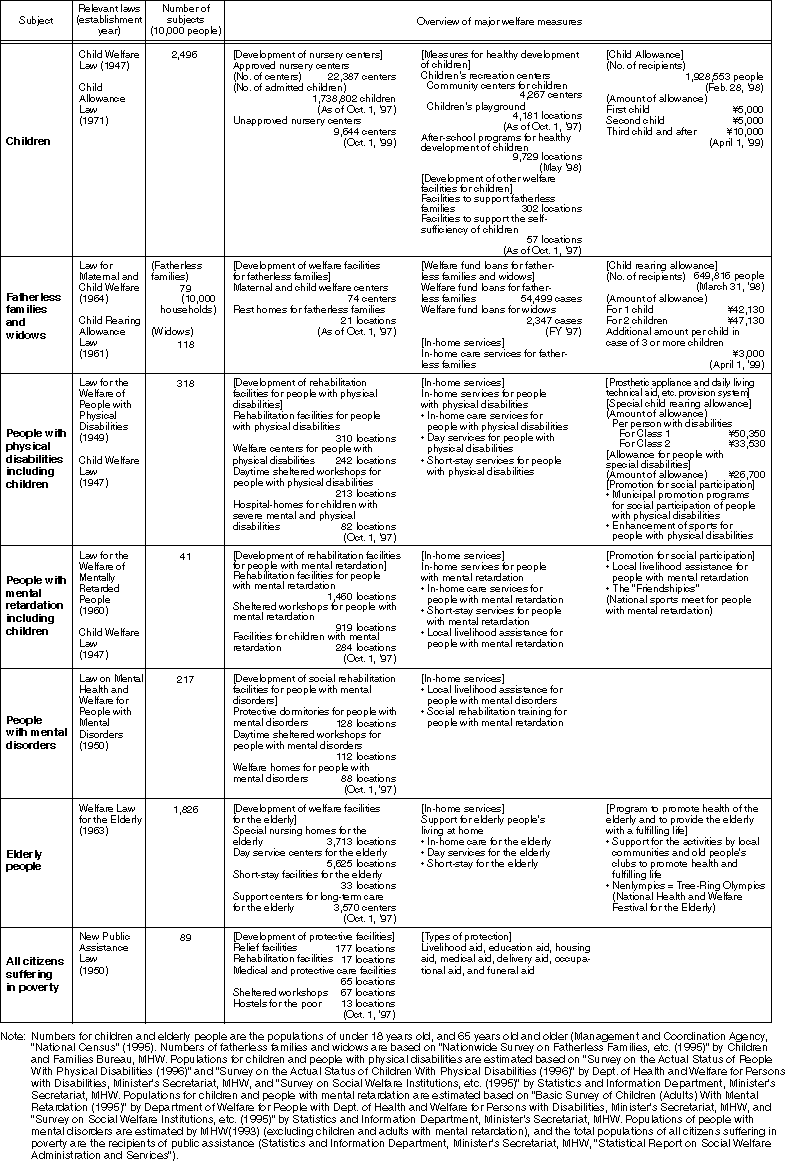
1. Characteristics of the Activities in Social Welfare
Over 50 years after the war, the Social Welfare System has shown diversifying expansion and changes (Table 3-3-1). Particularly, the following changes are observed in the overall roles of welfare services.
The characteristics of welfare services are changing from special and selective services for poor to more general and universal services available to anybody who needs the services regardless of their income.
2 User-oriented mechanism and improved service quality
The mechanism for using the services is changing from the system that the administrative offices decide and provide certain services to a user-oriented system where users can select and use the services based on their decision. More specifically, the system is changing from a fixed system to a user contract system (See Chapter 1, Section 1), and also the discussion on the mechanism to support service users such as protection for people's rights and disclosure of information has started. In addition, the requests for changing from a fixed service to diversified high quality services are increasing to meet individual needs.
3 Municipality centered mechanism
In order to provide detailed services to meet the needs of local people, the service mechanism is shifting to more municipality centered. In the conventional system, municipality was processing administrative work for welfare as commissioned by the National agency, but during 1980s it was commissioned by service organization, and then in 1990 with the revision of welfare system, municipality was authorized to take leadership in improving the welfare of residents including the welfare for the elderly and for the people with physical disabilities. It has become important for municipalities to lead the improvement efforts for local welfare to meet the needs in their own communities.
Table 3-3-1. Overview of Social Welfare Measures

People have desires to live at home and in their local community as long as possible, and they are becoming awareness of the concept of normalization, which states that the normal condition should be for people with or without disabilities to live together in local community, and people with disabilities should also be able to live at home. For these reasons, local communities are improving in-home services to support the life of elderly at home, and the development of institutional services have been promoted with concrete plans.
5 Multi-dimensional system for providing services
Previously, services were mostly provided through administrative offices, social welfare foundations and council of social welfare, but these days services are also provided through various other entities such as private companies, non-profit organizations, local residents' groups, etc. Also, volunteer activities are increasingly becoming important.
6 Enhancement of cooperation among health care, medical care and welfare, and integration of services
Forms of services are also changing from independent services in each area of health care, the welfare and medical care to comprehensive services based on the mutual collaboration among those areas to support health and welfare services for elderly people and people with disabilities. This change is leading to the improvement of service quality and efficient management of administrative work.
2. Development of Social Welfare Systems
2-1. Improvement of Child Welfare
(Development of child welfare)
Around 1945 to 1955, the protection for juvenile vagrants and orphans who lost their parents and homes in the war was a urgent issue, and immediately after the war in October 1946, Bureau of Children was newly established in the Ministry of Health and Welfare to lead child welfare measures, and emergency relief measures for war orphans etc. were put in place. In December 1947 the Child Welfare Law was enforced as the fundamental law for child welfare measures. In addition, on the Children's day, May 5, 1951, the Children's Charter was established to stipulate the items that the people should comply to respect the fundamental human rights of children and to promote the happiness of children.
Around 1955 to 1965, while the population of urban areas was increasing with the progress of industrialization, it was pointed out that the families were losing their function of fostering children; playgrounds for children were lost in urban areas; and nuclear families and double-income households were increasing. While viewing these changes, healthy rearing for all children, not just for children requiring protection, became recognized as an important issue, and in 1963 a national subsidy system was created to fund the placement and operation of community centers for children.
Between 1965 and later 1970s, the development of nurseries made a major progress as many married women joined the work force during the period of high economic growth, and as the second baby boom (1973 to 1975) arrived. In 1971 the Child Allowance was established to provide financial assistance to ensure stable living of children at home as well as for their healthy growth.
Recently, the population of children is declining rapidly and various measures have been in place to create an environment where it is easier for people to have and raise children. With the emergence of new problems such as the increase of child abuse and delinquency, it has become necessary to improve the quality of childcare and consultations at nurseries in addition to assuring the quantity of services available.
These days based on the Child Welfare Law, various projects were put in place to support children. Such healthy child rearing projects including nursery care measure through the admission to nursery centers, consultation program at child guidance centers, placement of community centers for children, after-school children's clubs, etc., and also some projects for supporting children requiring protection to become self-sufficient through the admission to residential child care facilities, and measures for children with disabilities. In addition, welfare projects for fatherless families were put in place according to the Law for the Welfare of Fatherless Families and Widows, such as loans of welfare funds for mothers (widows) with dependent children, consultation by counselor for fatherless families, etc. Furthermore, the health care department provides maternal and child health services that play an important role in the health management of infants, small children and pregnant women, and it also offers cash benefit system with child rearing allowance and child allowance
(Development of nursery centers)
Development of nursery centers was the top priority in child welfare measures. Nursery centers are child welfare facilities to provide childcare while parents are not available for giving care to their children during the day because both of them are working or for some other reasons. In 1947 when the Child Welfare Law was enacted, only 1,476 nursery facilities were available nationwide with the admissions of 135,503 children.However, with the changes in industry structures and high economic growth in 1965 to late 1970s, the demands for nursery facilities increased and those facilities were built rapidly through the formulation and implementation of "Five-Year Plan for the Emergency Provision of Social Welfare Facilities" that started in fiscal 1971. In addition, day care for babies began in 1969 as a special measure. Through the period of rapid increase of nursery facilities, the total number reached 22,387 facilities with the admissions of 1,738,802 children in October 1997. This is more than 10 times of increase since late 1940s.
The number of admissions to nursery facilities hit the peak in 1980, and with the decrease of the admissions the quantitative expansion of nursery facilities was no longer a national issue. However, various changes in society such as the increase of working women, the diversification of work hours, changes in the awareness of child education, and the increase of nuclear families, began to weaken the functions of home and local communities to provide childcare, and the quality improvement of nursery facilities has become an issue in response to diversified nursery care needs. Because of these changes, extended nursery care and night-time nursery care were implemented as a national project of special day-care measures, starting in 1981.
Furthermore, in response to the increase and diversification of nursery care needs with the increasing number of working women in recent years, nursery care for younger children and extended nursery care have been promoted based on the "Five-Year Program on Emergency Measure for Nursery Care and Other Related Matters", which was formulated in December 1994 (Table 3-3-2). Also, in 1997 a major amendment was made to the Child Welfare Law for the first time in 50 years, since its initial enforcement. Because of this amendment, starting in April 1998 the process to use nursery facilities was changed from the municipality assignment system (administrative measures) to a system to allow guardians to select their preferred nursery center.
Currently with the progress of society with fewer children, the number of pre-school age children is decreasing, but while child population is decreasing, the admissions to nursery facilities are increasing (Figure 3-3-3).Because of the increase, one in every five children of pre-school age in Japan is admitted to a nursery center.Nursery facilities are now playing a very important role in the care for children to lead our future, and also contributing to women to stay employed while taking their dual responsibilities of childcare and work.
Table 3-3-2. Overview of 3 Plans
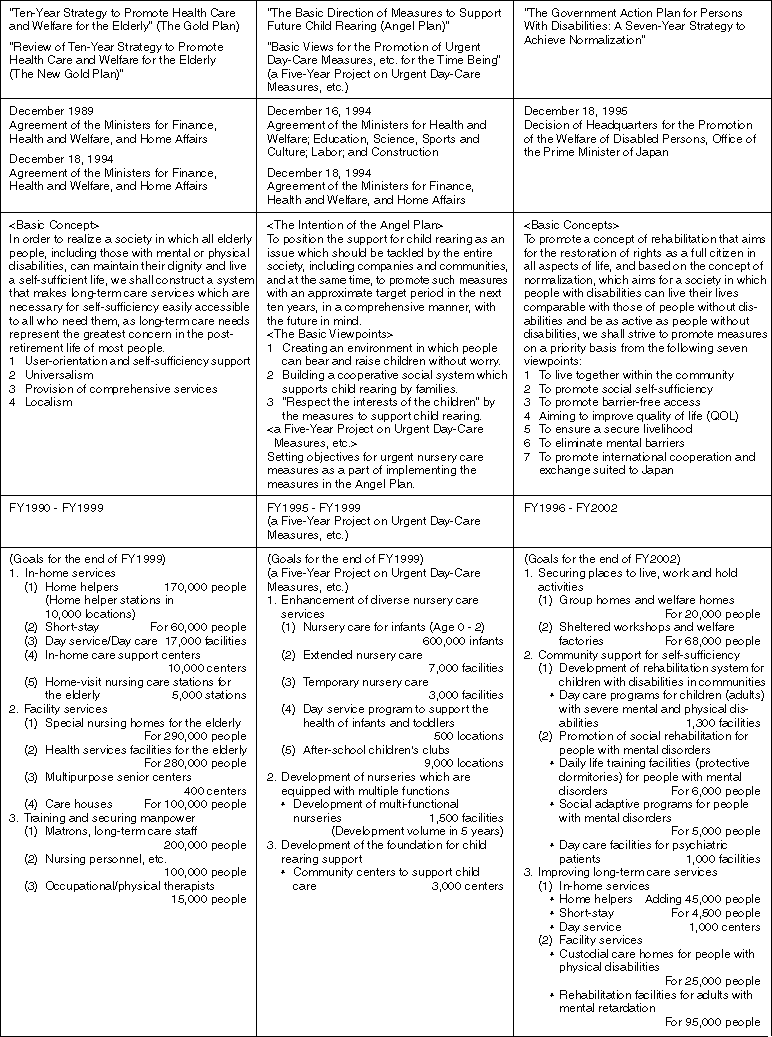
Figure 3-3-3. Changes in the Numbers of Nursery Centers and Admissions to Nursery Centers
(1) Changes in the number of admissions to nursery centers
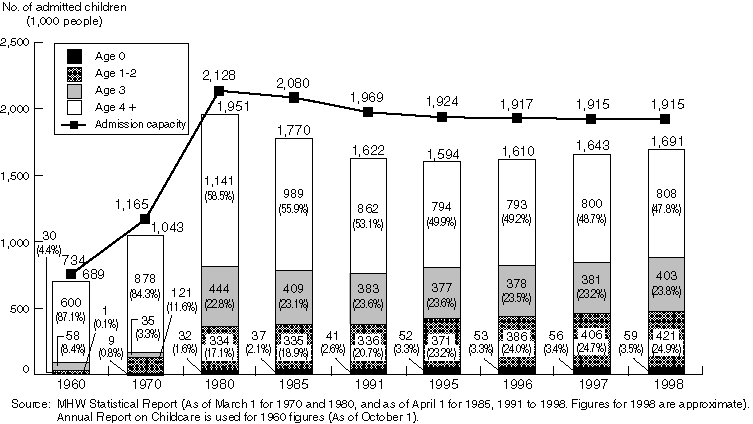
(2) Changes in the number of nursery centers
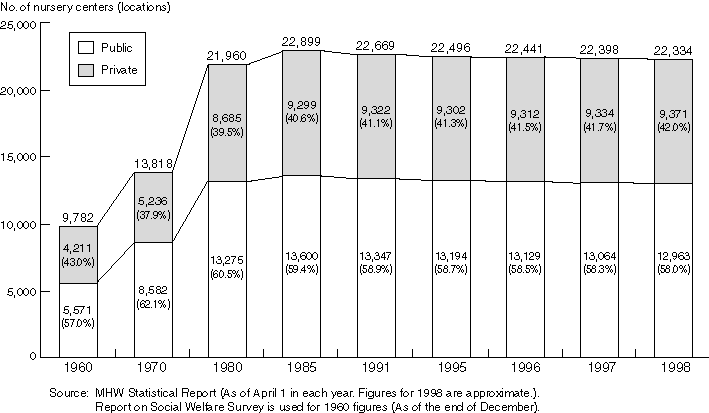
2-2. Improving Welfare for the Elderly
(Development of welfare for the elderly)
Aging in Japan is accelerating at a fast speed that no other developed nations have experienced before. The aging rate has already reached 16.2% in 1998, and 1 in every 6 persons of the total population is 65 years old or older. According to the population estimate for the future, one in four persons will be age 65 or older in around year 2020, and the aging rate will be about 25% to reach the world highest level.
The progress of welfare for the elderly has been a history of our efforts to meet the growing demands for welfare for the elderly with the advancement of aging. Before the enforcement of the Welfare Law for the Elderly in 1963, welfare for the elderly was limited to a very small number of people with low income, and those elderly people were housed in nursing facilities for the elderly in accordance with the Public Assistance Law.For a long time, living with multiple generations in a household has been a common practice in Japan and the care for the elderly has been considered as a responsibility of the family. However, the approaches to the care for elderly parents have gradually changed along with the changes in family system, family succession, and industry structure, and also with the increase of nuclear families as a result of population concentrated into metropolitan areas.
Upon the establishment of the Welfare Law for the Elderly, physical checkups were implemented and the system for special nursing homes for the elderly was established to admit any elderly people requiring long-term care without limiting to the elderly people with low income. Also, the home helper system for elderly-only households (current home-visit care) was institutionalized and the measures have become available to all elderly people who need social support. Systematic and comprehensive promotions of such measures started to improve welfare for all elderly people. However, when the Welfare Law for the Elderly had just enforced, the actual scope of welfare service users were limited to the elderly with low income, as observed in the facts that most welfare facilities for the elderly were nursing homes for elderly people with low income or indigents, and the subjects for home helper dispatch system were limited to the elderly with low income.
Welfare services for the elderly have become available to general elderly people after 1980s when the demands for welfare for the elderly increased rapidly with the extension of life expectancy, expansion of aging population, and remarkable increase of elderly-only households.
(Development of basic foundation through the promotion of the Gold Plan)
As reviewed in Chapter 1, medical care and pensions were the core items of the measures for the elderly during 1970s to 1980s, including the improvement of pension benefits, increase of medical insurance benefit ratio, free medical services to the elderly and the establishment of health service system for the elderly. Then, actions for improved welfare services and long-term care became important issues in late 1980s. Considering the support for families with elderly people requiring long-term care, the needs for the improved in-home services were emphasized. As a result, short-term care (short-stay) services and daily commuting care services (day services) were institutionalized and the number of home-visit care-givers (home helpers) was increased (Table 3-3-2).
Recent enhancement to welfare measures for the elderly is based on the Ten-Year Strategy to Promote Health Care and Welfare for the Elderly (the Gold Plan) which was formulated in the preparation of the recent conditions of aging society.
This plan was developed to aim for a large expansion of in-home and facility welfare services during the 10 years from fiscal 1990 with goals set for fiscal 1999 to respond the needs of aged society in the 21st Century.In December 1994, the plan was fully reviewed and the New Gold Plan was formulated to include many measures for further improvement of services through increasing the target values for the development such as the numbers of home-visit care-givers and special nursing homes for the elderly. It is now used as a plan for the second five years, starting in 1995.
Examples of specific measures include the promotion of single rooms in special nursing homes for the elderly, prevention of the bedridden through the implementation of the "Campaign to Reduce the Number of Bedridden Elderly People to Zero", meals on wheels service, promotion of research, development and distribution of welfare-related equipments, etc. In order to provide adequate long-term care to the elderly in need of care, formulation of care plans (long-term care plans) was included in the measures, and the system is growing to become a mechanism that create and offer comprehensive long-term care services in the scheme of public long-term care insurance system.
Since starting the plan to the present time, both in-home services with home helpers, day services and short-stay, and institutional services including special nursing homes for the elderly and health care facilities for the elderly have expanded remarkably in quantity (Figure 3-3-4).
Table 3-3-5 indicates the current status of the foundation developed for health and welfare services by converting the target values of the New Gold Plan into the case with 10,000 elderly people of age 65+. Base on this table, it is clear that a variety of services are easily accessible to the elderly.
Figure 3-3-4. The Number of Special Nursing Homes for the Elderly and the Number of Home Helpers
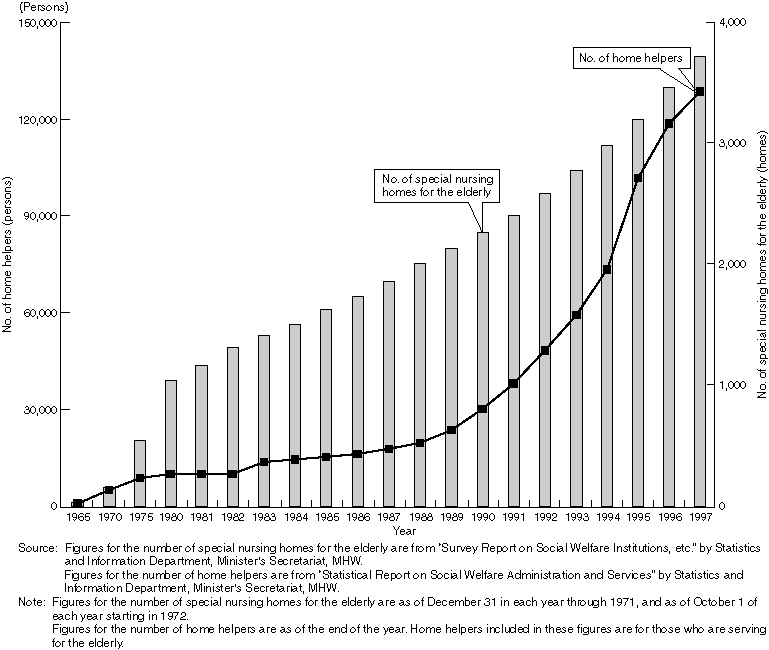
(Plans for health and welfare services for the elderly and long-term care insurance)
In 1990 when eight welfare related laws including the Welfare Law for the Elderly were revised, the administrative work for the admission of the elderly and people with disabilities was transferred to municipal offices from prefectural offices (Cities had already had the responsibilities). With this change both in-home welfare services and welfare for the elderly and disabled went under the management of municipality. At this occasion, all prefectures and municipalities were assigned to develop plans for health and welfare for the elderly and to set the target values for the development of various services by fiscal 1999 to promote comprehensive and systematic implementation of health and welfare services for the elderly in their responsible areas, and by fiscal 1993 most local governmental offices in Japan had completed the development of their plans.
The establishment of the mechanism for municipalities to lead the implementation of health and welfare services for elderly people was a significant change. Currently, more than 10% of total municipalities in Japan have already exceeded the aging rate of 30%. Including urban areas, the improvement of health and welfare measures for elderly people has always been a top ranking request from residents to local administrative offices.
Table 3-3-5. Foundation for Health and Welfare Services Developed for 10,000 Elderly People of Age 65+
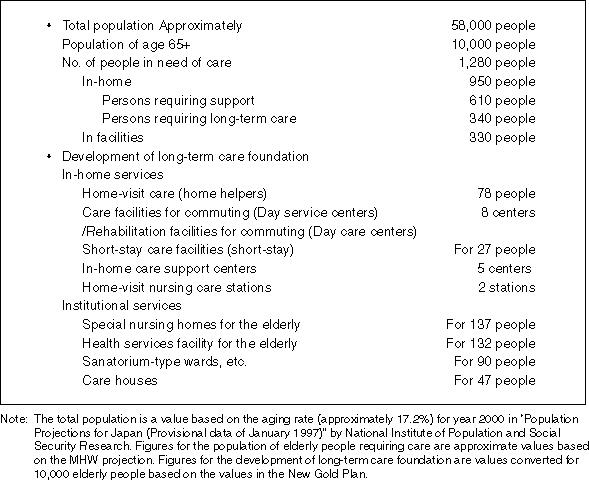
The public long-term care insurance system to be effective in April 2000 will further emphasize the importance of the role that the municipalities play. The public long-term care insurance system has been developed by totally reorganizing the current welfare system for the elderly in combination with the medical services for elderly people requiring care, and aims to offer a large part of conventional welfare services for the elderly through the mechanism of social insurance. Municipalities are positioned as the insurers that operate the public long-term care insurance system, and they are expected to take leadership in creating business plans for the long-term care insurance and developing infrastructure for long-term care services based on the plans.Their responsibilities also include creating a community in which residents can live with sense of security by resolving their concerns about long-term care through the administrative work to certify the long-term care needs, management of insured, handling of insurance benefits, etc.
2-3. Improving Welfare for People with Disabilities
(Scope of welfare for people with disabilities)
It is estimated that in Japan there are about 3.18 million people (children) with physical disabilities (FY1996), about 0.41 million people (children) with mental retardation (FY1995), about 2.17 million people with mental disorders (FY1996), and the total of 5.76 million people with disabilities.
Welfare services for people with disabilities have developed for each type of disabilities independently, and the history of those services cannot be simply generalized. However, the overall measures and services have been developed by extending range of disabilities that are subjects for the welfare for people with disabilities, increasing the types of welfare services and quantities, and promoting the social participation and support for self-sufficiency. Compared to welfare services for children and the elderly, welfare services for disabilities have different aspects as strong efforts were made for the promotion of self-sufficiency and social participation through the services of sheltered workshops and vocational training in addition to the support for living.
Through the activities of International Year of Disabled Persons (IYDP) in 1981 and "United Nations (UN)Decade of Disabled Persons" in 1983, the concept of "Normalization", which states that the normal condition for all people with or without any disabilities should be able to lead their lives together in the community, and we should create the environment where people with disabilities can lead their normal lives at home and in community, was filtered into people's mind, and the measures for disabled people are gaining recognition as services for general public instead of for particular types of people.
In 1993 the Government formulated "the New Long-Term Program for Government Measures for Disabled Persons" as the basic guidance for the future measures for people with disabilities. In order to further promote the self-sufficiency and social participation of people with disabilities, the Fundamental Law for Countermeasures for Mentally and Physically Handicapped Persons was revised as the Fundamental Law for People with Disabilities to clarify the basic principles of measures for people with disabilities, provision of Disabled Person's Day, formulation of basic plans for people with disabilities, and the responsibilities of the national and local governments in the efforts to propel the employment of people with disabilities.
Table 3-3-6. Social Welfare Institutions, etc.
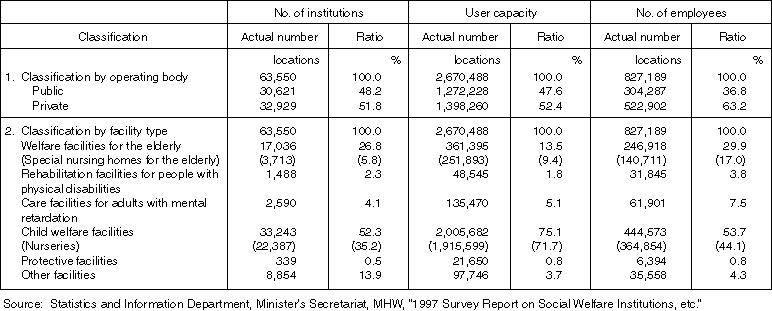
(Promotion of the Government Action Plan for Persons with Disabilities)
Recent measures for people with disabilities are centered on the projects based on"The Government Action Plan for Persons With Disabilities: A Seven-Year Strategy to Achieve Normalization", which was created by the Headquarters for the Promotion of the Welfare of Disabled Person in December 1995. This is a seven-year plan starting in fiscal 1996 created as priority measures for the realization of "New Long-Term Program for Government Measures for Disabled Persons" (FY1993 to FY2002). According to this plan, concrete target figures for fiscal 2002 are identified, and additional construction of group homes as well as welfare homes and increasing home helpers are considered as urgent measures for the development of health and welfare services for disabled persons. Those projects are now in progress in accordance with the plan (Table 3-3-2).
(Establishment of the service utilization system and support of self-sufficiency)
Traditionally, welfare services for disabled persons have been provided through the provisional system in which the local governmental body makes the assessment on needs for welfare services and decides types of services provided and who should provide the service, whether the local administrative office itself or an appropriate contractor selected by the local administrative office. The conventional system for providing welfare services has played an important role in the past as it allows the community office to assess the needs of disabled persons and to offer welfare services on order of higher needs, and also it enables the community office to be actively involved with the disabled persons and their families to offer welfare services when those people are not aware of the needs for welfare services.
However, considering the concept of normalization and the realization of the principle of making own decisions, it became necessary to build a system to utilize welfare services based on the concept of user-orientation to respect the dignity of individual people by respecting user's choice and establishing direct and equal relationship between users and the providers of welfare services.
As observed in health and welfare service measures for people with mental disorders, it is becoming increasingly important to improve a variety of measures to expand vocational training and employment opportunities for disabled people through the enhancement of cooperation among health, medical and welfare services and supporting self-sufficiency to further promote the social participation of people with disabilities.
2-4. The Development of Social Welfare Services
As of October 1997, the total number of social welfare institutions in Japan was 63,550 facilities with total capacity of 2,670,488 users and 827,189 employees, which is very large in size. Compared to the figures in 1970, those numbers increased 2.7 times, 1.9 times, and 3.3 times respectively. While one third of all social welfare institutions are nursery facilities, the number of welfare facilities for the elderly such as special nursing homes for the elderly is growing rapidly in recent years. When comparing 1985 and 1997, the total number of welfare facilities increased 1.3 times, and the growth of the welfare facilities for the elderly is 3.7 times, higher than the total growth size (Table 3-3-6).
About a half of social welfare institutions are created and operated by private organizations such as social welfare foundations. While local governments operate more than a half of nurseries, social welfare foundations are managing and operating more than 90% of special nursing homes for the elderly and custodial care homes for people with physical disabilities.
Social welfare foundations are non-profit charitable corporations established in accordance with the Social Welfare Service Law for the purpose of providing social welfare services. The social welfare foundation system was created to maintain the consistency with Article 89 of the Constitution that prohibits the spending of public funds to charitable activities ruled by non-public functions as well as to secure the reliability, pubic nature of social welfare services, and continuation of the services. The system has played important role in the development of social welfare services. In addition to the social welfare foundation system, provisional commission systems to social welfare foundations by local government body based on various welfare laws and tax measures to correspond the social welfare foundation system have been supporting the placement and operation of social welfare institutions of such foundations.
The number of social welfare foundations increased from 6,110 in 1975 to 15,961 in 1997. Recently, there were some scandals caused by the abusive use of social welfare foundation system, but the true purpose of the system is to allow the operation of services with creativity of private entities while maintaining the public functions and continuity of social welfare foundations. We must continue our efforts for the proper operation and healthy development of welfare foundations.
Along with the expansion of social welfare services, not only social welfare foundations but also diverse business entities are entering into the area of welfare services, and the improvement of service quality is now expected through the quantitative increase of services and healthy competition. As an example, civil law-based corporations including welfare public corporations, agricultural cooperative associations, cooperative societies, and private companies are already playing important roles for in-home service for the elderly. With the implementation of the public long-term care insurance system, more private companies of different kinds are expected to enter in this area. Also, upon the revision of the Medical Service Law in December 1997, non-profit medical corporations (former medical juridical corporations) are permitted to provide social welfare services such as home-visit care. Thus, the area of social welfare services is becoming "multidimensional welfare services" where diverse entities provide services using their strength.